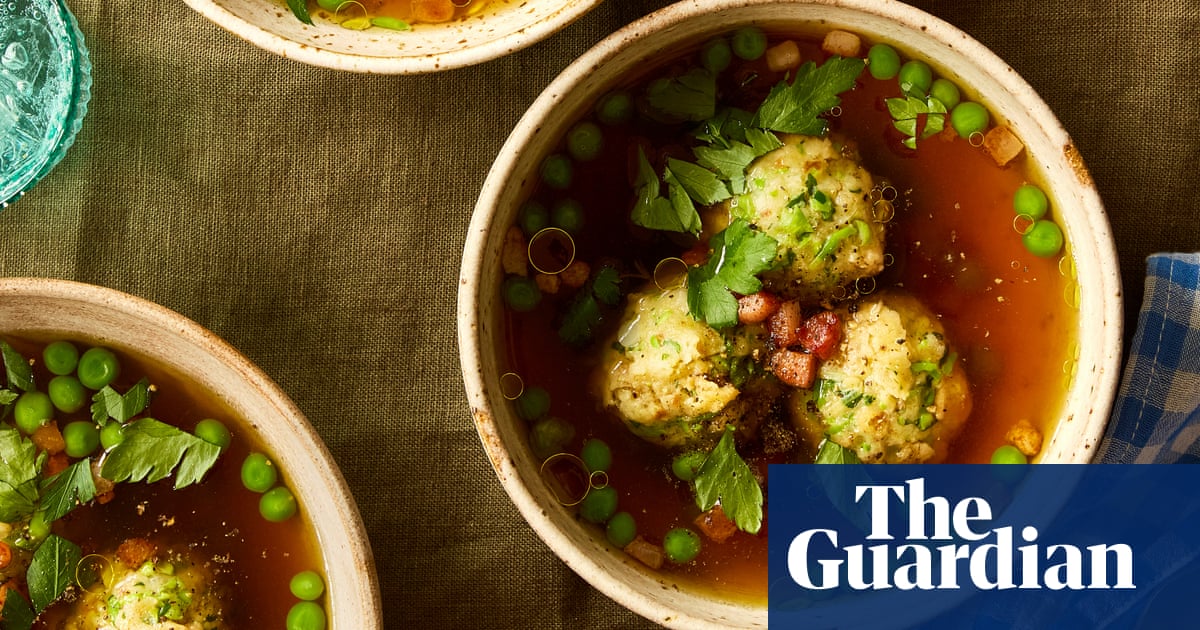My earliest memory of kitchen dutiesis sitting on a stool in our courtyard in Kenya with a sack of peas that was bigger than me. I spent hours coaxing them from their pods, munching as I went; the result was a red plastic bucket brimming with peas like gleaming green marbles. As with asparagus, they have a short season, so grab them while you can: throw them whole into salads, broths and curries, or grind them down and use their starchy goodness to make pestos, pancakes and fritters.
These herbal dumplings are made from the sturdiness of stale bread, cheese and sweet peas. I’ve used pecorino, but you could use parmesan or a hard goat’s cheese instead.
Prep20 minCook35 minServes4
For the dumplings30g butter1 leek, white part only, washed and very finely chopped1 large egg, beaten250g stale sourdough, torn into small piecesFinely grated zest of1 lemon50gpecorino1 heapedtbsp plain flour125g podded fresh peas,or defrosted frozen peas, coarsely ground2tbsp chopped tarragon2tbsp finely chopped parsley,plus extra to serveSea salt and black pepper1-2tbsp milk
For the broth1 litre chicken stock, or vegetable stock200g peas, fresh or frozen1tbspolive oil(optional)100g guanciale or pancetta, cubed (optional)Juice of½ lemon
Melt the butter in a frying pan, then gently saute the leek until soft but not coloured, then take off the heat and leave to cool. Meanwhile, in a large bowl, combine all the remaining dumpling ingredients apart from the milk, then add the cooled leek and season. Add enough of the milk to make a soft dough, then, with wet hands, form the mix into ping-pong ball-sized dumplings and refrigerate.
Pour the stock into a large saucepan and bring to a boil. Add the dumplings, and simmer for 10-12 minutes, adding the peas for the last minute of cooking. If you’re using the guanciale, heat the olive oil in a small frying pan, fry the cubed meat for five to six minutes, until crisp, then drain on kitchen paper.
Season the broth to taste and squeeze in the lemon juice. Divide the dumplings and peas between four soup bowls, ladle the broth over the top, add the guanciale, if using, and serve with extra parsley.
I regularly make these for breakfast or lunch; you could use spinach or any other greens instead, or cooked beetroot for vibrant purple pancakes.
Prep15 minSoak6 hr+Cook35 minMakes8
100g whole mung beans200g podded fresh peas, or frozen and defrosted peas1 thumb-sized piece fresh ginger, peeled and grated1 green chilli, finely chopped1 handfulcoriander, finely chopped1tsp cumin seedsSea salt, to tasteCoconut oil, or avocado oilFried eggs,to serve
For the coriander coconut chutney100gcoriander, stalks and all, roughly chopped100g grated coconut(you can buy this frozen)1 green chilli, roughly choppedJuice of 1 juicy lime½tsp caster sugar2½cm piece fresh ginger, peeled and roughly chopped
Rinse the mung beans well, cover with double the amount of water and leave to soak for at least six hours, or overnight.
To make the chutney, put the coriander, coconut, green chilli, lime juice, sugar, salt to taste, ginger and 100ml ice-cold water in a blender, and blitz smooth.
To make the cheelas, put the peas, ginger, chilli, coriander and a splash of water in a food processor and blitz smooth.
Drain the mung beans, add them to the pea mix with the cumin seeds and sea salt to taste, and blend again. Add roughly 100ml water and blend until the mix has the pouring consistency of crepe batter.
To cook, lightly oil a cast-iron or nonstick frying pan and put it on a low-medium heat. Pour a ladleful of batter into the centre of the pan and, using the back of the ladle, circle and spread the batter to make a thin pancake. Drizzle a little oil around the sides and in the centre of the cheela, then cook on both sides for two to three minutes, until golden and crisp. Transfer to a plate, and repeat with the remaining batter, cooling the pan with a splash of cold water before making the next cheela. Serve with fried eggs and the chutney.
This makes a wonderfully bright pesto that is also excellent with grilled fish such as trout.
Prep10 minCook20 minServes4
Sea salt andblack pepper100gbasil25g mint, picked250g podded fresh peas, or frozen and defrosted1 fat garlic clove,peeled and finely chopped30g pine nuts, toasted30g pecorino or parmesan, grated, plus extra for sprinklingFinely grated zest and juice of1 lemon60ml extra-virgin olive oil250gtrofie, or other pasta shape of your choice1 handful pea shoots(optional)
Bring a large pan of heavily salted water to a boil. Meanwhile, put the basil, mint, half the peas, the garlic, pine nuts, cheese, lemon juice and zest into a blender, season and whizz to a puree. With the motor still running, slowly drizzle in the oil until it’s all incorporated and you have a vibrant pea paste.
Cook the pasta according to the packet instructions, adding the remaining peas for the last minute of cooking. Drain, reserving a ladleful of the pasta cooking water.
Stir the pesto and a little pasta cooking water through the hot pasta and peas, then add the pea shoots, if using. Divide between four bowls and serve sprinkled with more grated pecorino or parmesan.
